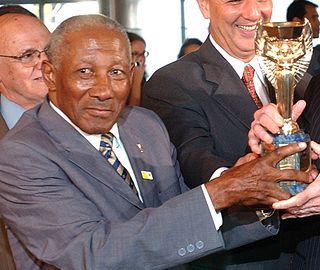
Carlos Alberto Valderrama Palacio, also known as "El Pibe", is a Colombian former professional footballer and sports commentator for Fútbol de Primera, who played as an attacking midfielder. Valderrama is considered by many to be one of the greatest South American players in history and one of the best players of his era. In 2004, he was named by Pelé in the FIFA 100 list of the world's greatest living players.

In the sport of association football, a forward is an outfield position which primarily plays further up the pitch than midfielders and defenders. As with any attacking player, the role of the forward relies heavily on being able to create space for attack. Their advanced position and limited defensive responsibilities mean forwards normally score more goals on behalf of their team than other players.

In the sport of association football, a midfielder is an outfield position which plays primarily in the middle of the pitch. Midfielders may play an exclusively defensive role, breaking up attacks, and are in that case known as defensive midfielders. As central midfielders often go across boundaries, with mobility and passing ability, they are often referred to as deep-lying midfielders, play-makers, box-to-box midfielders, or holding midfielders. There are also attacking midfielders with limited defensive assignments.

Carlos Alberto "Capita" Torres, also known as "O Capitão do Tri", was a Brazilian football player and manager who played as an attacking right-sided full-back or wing-back. A technically gifted defender with good ball skills and defensive capabilities, he is widely regarded as one of the best defenders of all time. He also stood out for his leadership, and was an excellent penalty taker. Nicknamed O Capitão, he captained the Brazil national team to victory in the 1970 World Cup, scoring the fourth goal in the final, considered one of the greatest goals in the history of the tournament.

Djalma Pereira Dias dos Santos known simply as Djalma Santos, was a Brazilian footballer who starred for the Brazil national team in four World Cups and winning the 1958 and 1962 editions. Santos is considered to be one of the greatest right-backs of all time. While primarily known for his defensive skills, he often ventured upfield and displayed some impressive technical and attacking skills.

In the sport of association football, a defender is an outfield player whose primary role is to stop attacks during the game and prevent the opposition from scoring.

Team tactics as well as individual skills are integral for playing association football. In theory, association football is a very simple game, as illustrated by Kevin Keegan's namely assertion that his tactics for winning a match were to "score more goals than the opposition". Tactical prowess within the sport is nonetheless a craftsmanship of its own, and one of the reasons why managers are paid well on the elite level. Well-organised and ready teams are often seen beating teams with more skillful players on paper. Manuals and books generally cover not only individual skills but tactics as well.

In the sport of association football, each of the 11 players on a team is assigned to a particular position on the field of play. A team is made up of one goalkeeper and ten outfield players who fill various defensive, midfield, and attacking positions depending on the formation deployed. These positions describe both the player's main role and their area of operation on the pitch.

Eduardo Gonçalves de Andrade, generally known as Tostão, is a Brazilian former professional footballer who played as a forward or attacking midfielder.

Soccer AM was a British football-based comedy talk show, produced by Sky Sports. It aired from 20 August 1994 to 27 May 2023 on Sky Showcase, Sky Sports Premier League and Sky Sports Football. From 2010, the programme was put on a short broadcast delay in order to edit bad language and/or inappropriate content from guests.

In association football, a bicycle kick, also known as an overhead kick or scissors kick, is an acrobatic strike where a player kicks an airborne ball rearward in midair. It is achieved by throwing the body backward up into the air and, before descending to the ground, making a shearing movement with the legs to get the ball-striking leg in front of the other. In most languages, the manoeuvre is named after either the cycling motion or the scissor motion that it resembles. Its complexity, and uncommon performance in competitive football matches, makes it one of association football's most celebrated skills.
Patrick Pule "Ace" Ntsoelengoe OIS was a South African soccer player who is widely considered as one of the greatest the country has ever produced.

Helenio Herrera Gavilán was an Argentine-French football player and manager. He is best remembered for his success with the Inter Milan team known as Grande Inter in the 1960s.
In association football, a playmaker is a footballer who controls the flow of the team's play, and is often involved in offensively and defensively playing passing moves which lead to goals, through their vision, technique, ball control, creativity and passing ability.

Shoot! is a Japanese manga series written and illustrated by Tsukasa Ōshima. It was published in Kodansha's Weekly Shōnen Magazine between 1990 and 2003. The story revolves around a boy named Toshihiko Tanaka, who had just started at Kakegawa High School in order to play association football with his idol, Yoshiharu Kubo. Toshi's friends were not interested in playing football again until he convinces them to join the team and soon the team would enter the All-Japan High School Championship.
Passing the ball is a key part of association football. The purpose of passing is to keep possession of the ball by maneuvering it on the ground between different players with the objective of advancing it up the playing field.
In association football, a long ball is a pass attempt that moves the ball a long distance on the field via one long aerial kick from either a goalkeeper or a defender directly to an attacking player, with the ball generally bypassing the midfield. Rather than arrive at the feet of the receiving attacking player, the attacker is expected to challenge the opposing defence in the air, with other attacking players and midfielders arriving to try and take possession of the ball if it breaks loose. It is a technique that can be especially effective for a team with either fast or tall strikers. The long ball technique is also a through pass from distance in an effort to get the ball by the defensive line and create a foot race between striker and defender. While often derided as either boring or primitive, it can prove effective where players or weather conditions suit this style; in particular, it is an effective counter-attacking style of play in which some defenders can be caught off-guard.

In association football, a cross is a medium- to-long-range pass from a wide area of the pitch towards the centre of the field near the opponent's goal. Specifically, the intention of a cross is to directly bring the ball into the box from an angle that allows the attacking forwards to more easily aim for goal with their head or feet. Crosses are generally airborne (floated) to clear nearby defenders, but can also be hit with force along the ground (drilled). It is a quick and effective move.

Association football was first codified in 1863 in England, although games that involved the kicking of a ball were evident considerably earlier. A large number of football-related terms have since emerged to describe various aspects of the sport and its culture.

A header is a technique that is used in association football to control the ball using the head to pass, shoot, or clear. This can be done from a standing, jumping, or diving position. Heading is a common technique and is used by players in practically every match. Although a useful technique in football, heading carries significant health risks, particularly to the brain, and governing bodies have taken measures to address these risks.















